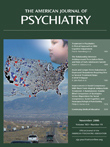Psychiatric illnesses are multidetermined disorders with many factors contributing to the development of the illness. The challenge for clinicians is how to incorporate information about these factors into the diagnostic criteria because the current DSM structure does not easily accommodate information containing varying degrees of relevance for the diagnosis. This problem can best be resolved in the context of the infrastructure or underlying information framework of DSM. An infrastructure is a collection of functions that specify how a system gathers, organizes, analyzes, and communicates information. DSM needs flexible infrastructure functions that can incorporate future clinical, endophenotypic, and genetic information into the diagnostic criteria in a manner that weighs this information according to its apparent importance for the diagnosis
(1) . These weights could be based on the prevalence of the information, its relationship to the outcome of the illness, or some other relevant measure.
DSM already has a primitive criteria weighting system. The characteristic symptoms of schizophrenia (criterion A) assign bizarre delusions twice the weight of nonbizarre delusions in the diagnosis. Currently, however, there is insufficient evidence from well-controlled studies to justify this distinction
(2,
3) . What is needed is information about differences in the prevalence of the two types of delusions or their relationship to the course of the illness. If, for example, an epidemiological study showed that 70% of the patients with schizophrenia and 5% of the patients with other psychoses experienced bizarre delusions, whereas 30% of the patients with schizophrenia and 25% of the patients with other psychoses experienced nonbizarre delusions, the data might justify the twofold increased weight given to bizarre delusions in the diagnosis of schizophrenia. The weighting might also be justified if research showed that patients with schizophrenia with bizarre delusions had a significantly higher morbidity than those with nonbizarre delusions.
Neurocognitive information may also be useful in the diagnosis of schizophrenia. Several groups have reported that patients with schizophrenia score significantly lower on neuropsychological tests of verbal memory than healthy comparison subjects
(4 –
6) . In one large well-controlled study of verbal memory, patients with schizophrenia scored 1.33 standard deviations below the mean for comparison subjects
(6) . The results explained 10.4% of the variance in the patients’ long-term global psychosocial functioning. One way to incorporate this information into DSM might be to establish a diagnostic weight based on the variance in a standardized measure of long-term functioning similar to the one in this study. The weight would be applied to the diagnosis of patients who scored below a threshold—perhaps one standard deviation below the mean for comparison subjects on tests of verbal memory.
Current genetic studies suggest that some alleles contribute a small but measurable increase to the risk for schizophrenia
(7) . Egan and colleagues
(8) showed that the Val allele of a functional polymorphism (Val
108/158 Met) of the catechol-
O -methyltransferase (COMT) gene explained 4% of the variance between schizophrenia patients and comparison subjects in the frequency of perseverative errors on the executive cognition subtest of the Wisconsin Card Sorting Test. They suggested that this allele slightly increased the risk of developing schizophrenia. This variance data, like that for verbal memory, could potentially be used to create a diagnostic weight that would be incorporated into DSM criteria.
Another way to think of a diagnostic weight is as a measure of the risk or vulnerability conferred by a symptom, endophenotype, or allele. The cumulative risk score can be calculated by using an algorithm to combine the individual risk factors. There is some precedence for this approach in obstetrics where a first-trimester diagnostic screen is used to assess the risk that a fetus has trisomy 21 or 18
(9) . The screen includes maternal age, serum levels of free beta human chorionic gonadotropin and pregnancy-associated plasma protein A, and an ultrasound estimation of fetal nuchal translucency. Patients found to be at high risk are offered a definitive but more invasive karyotype analysis. Risk is calculated by using algorithms that were developed by the Fetal Medicine Foundation of London. Although there are obvious differences between obstetric and psychiatric risk assessments, the basic concept seems relevant to a psychiatric diagnosis.
DSM is a nominalist diagnostic system in which a diagnosis is a name for a collection of signs, symptoms, and biological markers that appear to describe a coherent clinical disorder. Patients who suffer from an illness bear a family resemblance to one another rather than displaying the exact same signs and symptoms. The diagnosis says nothing about the cause of the disorder. The incorporation of a risk weighting system into DSM can add new, potentially useful diagnostic information that was not previously available to clinicians.

